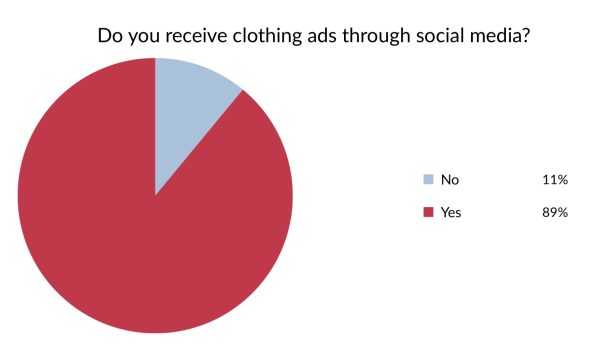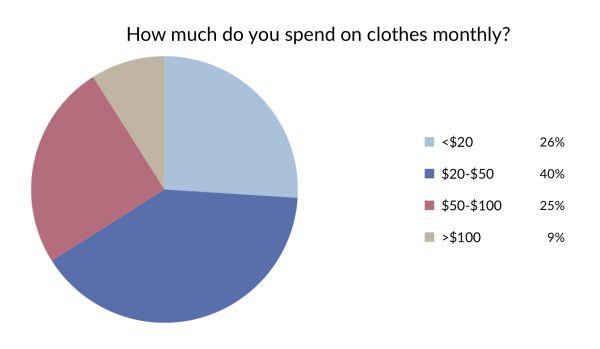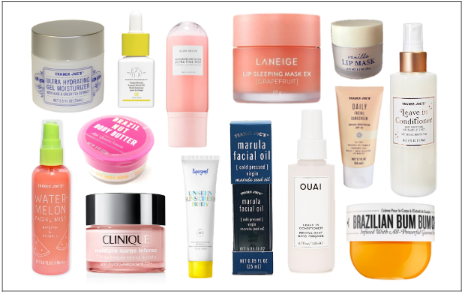It’s 10:00 am on a Sunday, and Lucy Anselm (‘25) is scrolling on Instagram. An ad for the infamous fast fashion brand, SHEIN, is the first thing on her feed: “500 dollar SHEIN haul and everything was free.” Instead of looking at the cheap, cute clothes, Anselm notices the individually packaged items in plastic bags—all of which likely cannot be recycled.
“I think that [fast fashion] is advertised a lot more than sustainable fashion, especially with the prices and [influencers that are] sponsored by certain brands,” Anselm said.
Fast fashion is quickly gaining popularity, so a sustainable option is likely necessary for a greener future.

On an Instagram poll, a whopping 89% of high school students (135 out of 151 responses) reported they receive clothing ads through social media.
Influencers certainly add to clothing propaganda. Zivah Hartman (‘25) agrees upon the relevance of sponsored content.
“A lot of things that [fashion influencers] think are not fast fashion can actually end up being [non-recyclable] or they just care more about the brand deals,” Hartman said. “[Shoppers also] think something is not fast fashion, but they’re not [properly] educated about a lot of false information on social media.”
Most of the advertisements for clothing brands today are online, which take over the actual shopping experience as well.
“I think it’s a lot more convenient to shop online,” Anselm said. “A lot more people are shopping online. Businesses are shifting to be more online purely. There’s a lot of businesses that don’t even have stores in-person.”
The digitalization of the clothing industry makes shopping faster and cheaper, but this is accompanied with serious environmental consequences.
“The fashion industry uses more than 98 million tons of non-renewable resources annually, including oil to produce synthetic fibers, fertilizers for cotton plantations, and chemicals for producing, dyeing, and finishing fibers and fabrics” that contributes to the already existing problem within water waste and an “emission of about 1.2 billion tons of CO2” according to a peer-reviewed paper on fast fashion as it pertains to the environment (Gazzola, Pavione, Pessetti, & Grechi).
The reality is that the environmental situation is fueled by consumerism. In terms of high school students, trending items are a significant factor.
“The Stanley Cup is a good example of trends spreading, a lot of people bought it all at once,” Anselm said.
Anselm also notes that trends occur frequently at AGHS because of the desire to fit in.
“We definitely have aesthetic cliques [at AGHS],” Hartman said. “There’s a lot of people that follow a certain aesthetic.”
It’s no secret that high school students in today’s world have an eye for fashion, especially considering the speed of the fast fashion industry with its facilitation through social media and online stores. However, while teenagers are the fashionable generation, they just don’t have the financial foundation (partially because of inflation).

According to a poll conducted on Instagram, 40% of students (60 out of 151 responses) spend $20-$50 per month on clothes shopping. 25% of students (38 responses) spend $50-$100, and 9% (14 responses) spend more than $100 monthly. Most high school students require a job to support their purchases, but it isn’t ideal to pick up extra shifts to keep up with trends with increasing amounts of homework during the school year.
The solution? Second-hand clothing.
“[Shopping second-hand] is cheaper, and I’m broke,” Hartman said. “But, also, a lot of the styles I like are easier to find second-hand.”
For Hartman, there are multiple financial and stylistic benefits to thrifting. Not to mention, buying used clothing is sustainable and environmentally friendly.
“Most of my clothing is thrifted,” Hartman said. “I can find really good brands that last longer for a lot cheaper.”
Anselm also prefers the in-person experience that most second-hand clothing stores offer.
“I like going with my friends and making a day of it, especially when it comes to thrifting and getting coffee,” Anselm said.
In addition to thrifting, Anselm gets used clothing from her sisters.
“[My sisters] get giant things of [clothes] from the bins and then they go through all their old clothing and get rid of that, and I take their old clothing,” Anselm said.
There are many benefits to getting used clothing from both stores or friends and family. For teenagers in particular, opting for more sustainable ways to find new fashion helps them as well as the world that we live in. Prioritizing an environmentally conscious lifestyle through shopping habits is the first step toward curbing the negative effects of the fast fashion industry, as well as creating an easier way to “keep up with the clothes.”








